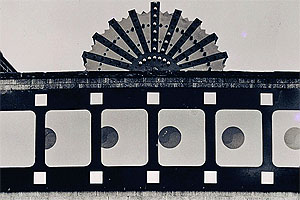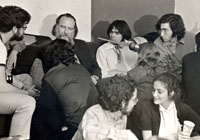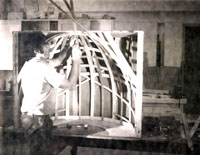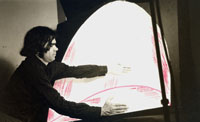

Today P.F.M.I. is directed by an energetic and dynamic woman by the name of Marilyn Levin. Marilyn is the fourth director in over a ten-year period, making possible independent cinema to survive in Pittsburgh. To commemorate this last decade it is always interesting to look back to see the influencing factors which created this successful film-making organization. There was an original dream which is still being kept alive today by the efforts of many dedicated people. Let us look back at the beginnings together.
In 1965 I graduated from Ohio University and immediately moved to San Francisco. San Francisco at this time was very colorful as I recall with a very friendly atmosphere. I was living in Pacific Heights at the time, and was overwhelmed to see so many people relaxing and talking about their personal experiences. For someone like myself just out of the business administration department at Ohio University the appearances of many people with flowing robes and flowers in their hair was something I did not immediately surmise to be the budding edge of a movement that would change the world. San Francisco in 1965 was a place where people congregated from all over the country and it was this social phenomenon that produced the colorful Haight-Ashbury district. During mid-1965 I returned to Boston and began working with Addison-Wesley college text book publishers as an editorial assistant. Shortly thereafter I was relocated to Pittsburgh and it was then I realized the colorful aspects of San Francisco were also emerging in Pittsburgh
Pittsburgh in 1965 was far different than it is today. It was in Pittsburgh that I witnessed the results of the spreading of the phenomenon that was taking place in the Haight-Ashbury district of San Francisco. The Shadyside section of Pittsburgh was like a mini-Greenwich Village of New York City. The sidewalks were packed with people. And there was never an evening when people would not stop strolling up and down Walnut Street then called, “the street of dreams”. People were taking time to be concerned with great thinkers, and a general concern for the well being of the planet was considered a realist goal. There were Earth Day events at the local universities and Buckminster Fuller was very popular with his views on “World Game” and “Space Ship Earth”. Marshall McCluhan was introducing his philosophy on media and it was McCluhan who woke me up from my print-oriented world, and prepared me for a career in the electronic media technologies. The publishing world of Boston, of which I was a part of, was slowly disintegrating for me as a profession.
Pittsburgh became my second home in 1965, and it was in Pittsburgh that I saw the first announcement for an extraordinary event called, “Expo 67”, at Horne’s department store in downtown Pittsburgh. When spring of 1967 came around I drove to Montreal, Quebec to attend the opening ceremonies. I went to Expo 67 expecting to see exhibitions on the latest technological achievements of mankind. Not only did I see new applications of technology, but I also saw for the first time, multi-images and the most incredible theatres. There was a labyrinth built by the National Film Board of Canada with five screens measuring 12’ x 16’ feet each arranged in the shape of a cross, and the Czechoslovakian’s Diopolyecran, a movable multi-image mural with 112 cube-like movie screens. Life Magazine Vol. 63 No. 2 (July 14) 1967 called it, “A Film Revolution to Blitz Man’s Mind”. Time Magazine (July 7) 1967 called it, “Magic Montreal”, and American Cinematographer 48/8 (August) 1967 called it, “ The Greatest Film Show on Earth”. I was so fascinated with the projection techniques that I returned to Montreal three times from Pittsburgh to see all the new ways cinema was being used in he exhibition pavilions.
With McCluhan effecting my personal philosophy I tried to figure out a way to explore and experiment on my own. I left the Boston publishing world, and convinced Jack Napor, President of WRS Motion Picture Labs of Pittsburgh to give me a job. I worked a short while learning film developing but then went and worked a short time with George Romero, President of the Latent Image in Pittsburgh who was then editing the now famous “Night of the Living Dead”. However, neither of these jobs seemed to capture what I experienced at Expo 67 in Montreal. During this time in Pittsburgh, Fall 1967, the atmosphere was obviously fertile for a lot of experimenting and creativity. Even though Pittsburgh in 1967 did not have a lot of independent film-making activity, I sensed that the climate was right. The thought occurred to me to have my own experimental theatre if ever I was to come close to experimenting with film as witnessed at Expo 67.
On July 1, 1968 on 5744 Ellsworth Avenue in the Shadyside district of Pittsburgh, I rented a store front building, and all I could think of at the time was to build some sort of new theatre. The store front became the New Cinema Workshop. Shadyside was the ideal place to build a film workshop. Directly across the street was Richard Fishkin’s “Head Shop” where most of the new generation got their supply of psychedelic paraphernalia. When the marquee was erected over he New Cinema Workshop showing the Tao symbol of yin/yang slowly emerging into the last film frame the “way” was paved to interface with the counter culture that was made popular by Theodore Rosak’s book: “The Making of the Counter Culture". The social mood during the time of construction was a never ending zeal to make things more visual, and to find unique ways to experience living. The influence of new drugs cannot be omitted as one of the catalysts which prompted people to act, but the new spirit of inventiveness as experienced at Expo 67 was another example of attempts to se our world in new ways. The New Cinema Workshop began to be known as a new center for talking about films, showing many of the new short films such as New York, New York and NFB's Bryan Larkin and his film "Walking", and the beginning stages of making films. I began teaching film making at the Ivy School of Professional Art headed by Morris Kershunbaum. It was here I met dozens of aspiring artists and film makers: Walter Steding, Richard Pian, Bernie Wodzinski, Greg Gans, and Donna Marie Spadoni who became my wife in June of 1971. Walter is playing electric violin with the hit group Blondie in New York, and Richard is an accomplished artist. The list could continue as the tempo of the late 60's even created political agitation. It was at this time that Theodore Hazlett from the Carnegie Institute made money available allowing me to film the SDS riots in Chicago.
Inside the New Cinema Workshop I built a cylindrical-like space called the film-chamber. The film chamber was a novel approach to viewing films on a curvilinear screen. The film-chamber had its own projection booth and the audience could view films on a newly designed curved screen surface rather than a flat surface which in turn created the illusion of 3-dimensional images. The viewing of films that created the illusion of 3-dimension became a full time fascination. The realism that was obtained by the optical effects of light reflecting from a curved surface prompted many discussions about the medium that was inherent in the film light patterns verses the content of the film. Many hours were spent analyzing the images on the curved screen surface. I can remember watching the NFB's film "toys" with total delight. The National Film Board of Canada was also developing a rectangular screen which was concave in nature utilizing curved tapered sides which also gave the illusion of another dimension besides the standard 2-dimensional imagery. The multi-curved screen was developed at the film chamber in Pittsburgh to allow a better visual integration of light patterns emanating from the screens' surface. The curved screen was a by-product of the late 60's when a strong visual sense was sought after.
References to the curved screen:
During all the construction stages of the film-chamber at The New Cinema Workshop many film showings in Pittsburgh were attended, and I told the Pittsburgh film-makers about the unique theatre that was being built in Shady Side to show experimental films. This was the catalyst that triggered the interest, and it was what I needed because shortly thereafter a great many people began to contribute their time and effort to make possible a center to make and show new films. To name everyone would be impossible, but some of the key people were:
Sally Dixon: Later to become curator of the film section at the Carnegie Museum of Art
Michael "Lemon" DeGeorge: Later to become second engineer for Different Fur Recording Studio in San Francisco which received an Academy Award for producing the sound track for "Apocalypse Now".
Chuck Glasmire: Had film showings in Pittsburgh at his "Crumbling Wall" coffee shop and became editor of "Film-Feedback". He now teaches film at the University of Indiana.
Walt Seng: Who later became one of Pittsburgh's outstanding commercial and portrait photographers.
When the New Cinema Workshop first began construction there was some doubt as to whether the attempt was realistic in Pittsburgh. Many people would stop into the Workshop during the construction period and instantly lent their support. Others expressed string doubt and would say Pittsburgh is no place to make films. However, there were simultaneous screenings of films in Pittsburgh at this time which increased the curiosity and interest of film as an art form. Here is a list of the films and film-makers which caused great controversy during the 1968-1969 period in Pittsburgh:
Vilot Sjoman's - "I am Curious Yellow"
Stan Brackhage - "Love Making I - II"
Jean-Luc Goddard - "Breathless", "A Woman is a Woman", Alphaville", "My Life to Live", and "Pierrot le Fou"
Fred Wiseman - "Titicut Follies"
The Kinetic Art - "A series of independent films shown at Carnegie Lecture Hall"
Genesis I and II - "A series of films from Hollywood shown at Carnegie Lecture Hall"
Jeff Begun - A professor at Carnegie Mellon University with ther "Experimental Film Group"
Marjorie Walker - A professor at CMU with the "Media-Workshop"
George Romero - A new film "Night of the Living Dead" which was written up in the Wall Street Journal with the title, " Newest New Wave? Pittsburgh makes a bid to be a movie center".
Norman Mailer - "Beyond the Law"
Dennis Hopper - "Easy Rider"
Ed Emshwiller - "Thanatopsis" and "Relativity"

Emile de Antonio - "In the Year of the Pig"
Robert Downey - "Putney Swope"
Yugoslavia - "Animator's film series"
Norman McLaren - "Walking"
These films and film-makers were popularly talked about everywhere in film circles in and around Pittsburgh at this time. Social consciousness was being aroused and the movement of new cinema was bringing excitement to aspiring film-makers. There was no stopping the interest in film coming to Pittsburgh now. Pittsburgh had acquired "film-fever". The mood for innovation and experimentation prompted the Associated Artists of Pittsburgh to invite Aldo Van Eycke, and experimental architect from Holland to be the juror for the 59th annual exhibition called "Our Environment". One of the selected entries was by Dr. Rolf Von Eckartsberg a psychologist from Duquesne University, and Herb Berman, a physicist from the University of Pittsburgh with a newly developed mobile cinema screen.
Also at this time many other critics were creating film-making cooperatives. Suni Mallo, editor of Film-Makers Newsletter, out of New York City, published a list of the cooperatives in Vol. 2 No. 4 (February) 1969. Gary Crowdus, editor of Cineaste Magazine also from New York City in issue 7 (Winter) 1968=69 featured the Film Chamber at the New Cinema Workshop. It was a natural evolution for the New Cinema Workshop to be the first headquarters for the Pittsburgh Independent Film-Makers Coop, and on April 30, 1969 I incorporated the coop as a non-profit organization in Harrisburg, Pennsylvania as the Pittsburgh Independent Film-Makes Inc. and a bank account was established to accept funds for the expansion of the coop. Shortly after P.I.F.I. was included in a listing with all the other coop's in the United States, and even the American Film Institute saw the rapid expansion and inaugurated the Community Film Workshop Council of which Pittsburgh's coop was included in their newsletter Vol. 1, No. 1, and Vol 1, No. 2, May and October of 1969. The nickname for the independent film-makers at this time was "Indie", and many references were made to the indies springing up over the country.
Soon the Pittsburgh Independent Film-Makers, Inc. was bustling with activities. Evenings at the New Cinema Workshop were filled with students from the Pittsburgh Free University and Allegheny Community College as well as other local colleges. Bob Haller who was the founding editor of Field of Vision was an added resource in 1969 for his historical background knowledge of film history along with Ken MacCrimmon, professor of film at Carnegie Mellon University. It is interesting to note that Bob Haller recently married Amy Greenfield, a film-maker dealing with the dance medium and who communicated frequently with the New Cinema Workshop in its begriming years. Bob Haller later wrote a History of the Pittsburgh Film-Makers but the period between Chuck Glasmire's Crumbling Wall coffee shop film showings in early 1969 to the new directors with Bob Costa and Robert Gaylor in 1971 was not included.
Dues were collected from the coop members to enable film stock to be bought and the first film titled: Positive/Negative was produced on a historical train depot in McKeesport, PA. By this time there were over forty members in the newly formed Pittsburgh Independent Film-Makers, Inc. These are the people who worked on he film Positive/Negative:
Susanna Levitz
Sandra Rutenberg
Michael Lies - Alcyone Films
David Kissell
John Bratina
Ken and Mildred Kemp
Michael Louik
David and kathy Klieger
Ray Dunlevy
Tim Kelly
Mark Provost
Bernie Rossi
Judy Cooper
Mary Dixson
Mr. amd Mrs. MacCrimmon
Rick Scheid
leo Marker
Syu Cohen
Beverly Taylor
Steve Radkoff
The film critics of Pittsburgh then saw reason to comment on the coop's activities and Frank Jones became the most ardent with his weekly comments appearing in the newspaper called. The Point. Don Miller of the Post Gazette came to see screenings and kept up to date on developments and in the May 22, 1969 edition of the Post Gazette announcements were made about experimental films coming to Carnegie Lecture Hall. During the summer of 1969 I was accepted to attend the "Summer Research Institute for Screen Study" in conjunction with McGill University and The National Film Board of Canada in Montreal Quebec. At McGill I studied with Dr. Donald Theall of the English Department as well as with Dr. Peter Ohlin. At NFB I studied with Mark Slade and Gordon Martin. It was at the NFB that I constructed another curved screen to explore how light patterns were reflected off of irregular surfaces and worked with Jules Hourdiaux from France who invented a screen which would reflect a 3-dimensional image when film was projected onto its surface.


When I returned to Pittsburgh after finishing at the Summer Research Institute I learned that the rapid growth of the Pittsburgh Independent Film-Makers caused many financial considerations to be overlooked. There was conviction and enthusiasm for the Workshop and the Coop, but slowly funding was not managed effectively, and even though many attempts were made to save The New Cinema Workshop the doors were closed in September of 1969. However, several months prior to the closing of the New Cinema Workshop one of Pittsburgh's most noted patrons of the arts became aware of the excitement and extensiveness of independent film in Pittsburgh. It was Theodore Hazelett, the same person who sponsored my documentary efforts in Chicago in 1968, who now through his generosity allowed a new generation of Pittsburgh Film-Makers to finally have a new home to create new realities on the silver screen with a grant from the Mellon Educational and Charitable Trust Fund.
The next chapter of the Pittsburgh Independent Film-makers was to be written by a coop member, Sally Dixon, whose energy, dedication and foresight, brought film-making in Pittsburgh to its full maturity. In September of 1970 I received a scholarship to attend the new Walt Disney funded art school The California Art Institute in Los Angles to continue exploring film and light images. Before I left for California I turned over the bank account of the Pittsburgh Independent Film-Makers Inc.to Bob Costa. From the Fall of 1970 to the Spring of 1971 Bob Costa and Robert Gaylor formed a newer organization called the Pittsburgh Film-Makers. On February 9, 1976, Connie Kienzle of the Pittsburgh Press announced the new headquarters for Pittsburgh's newest distribution point for underground films with her article titled: "Museum to Show Little Known Films". Film in Pittsburgh had finally reached the status of a legitimate art form with a new home at the Selma Burke Art Center in the East Liberty area of Pittsburgh.
Over the years the name Pittsburgh Independent Film-makers Inc. has under gone several name changes and many administrative personnel:
1969 - Pittsburgh Independent Film-Makers Inc.
1971 - Pittsburgh Film-Makers Association
1976 - Pittsburgh Film-Makers Inc
1980 - 2010 Pittsburgh Filmmakers